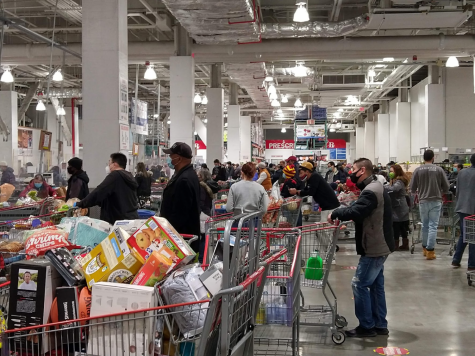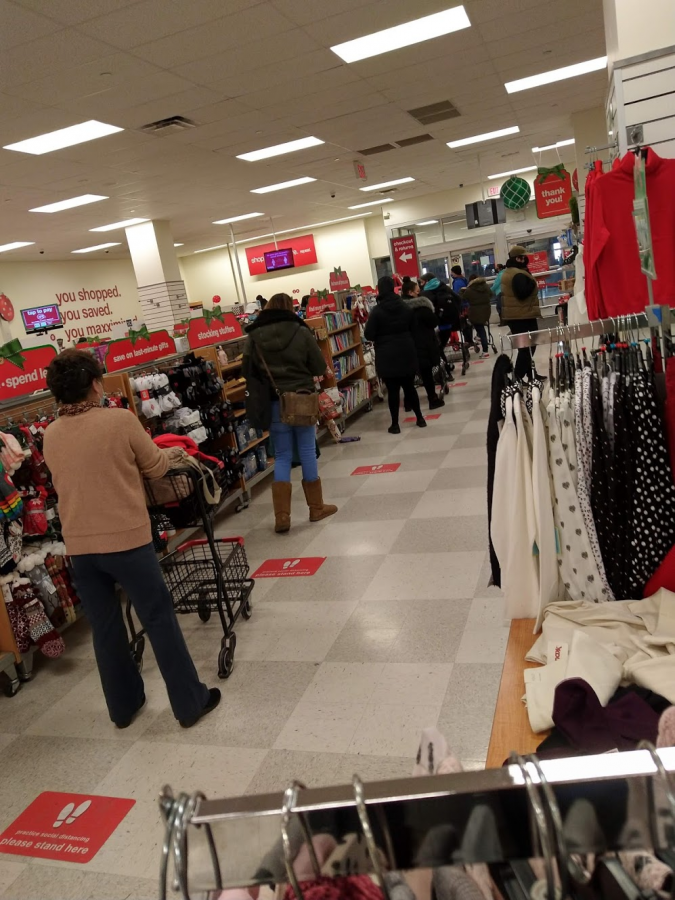COVID-19’s Impact on U.S. Holiday Shopping
T.J. Maxx customers try their best to socially distance while waiting in line to purchase their items in December 2020, during the Coronavirus pandemic.
What is usually one of the busiest times of the year was quite the opposite for many retail stores and malls in December 2020, due to the global Coronavirus pandemic, in which cases are spiking even as the vaccine has begun to be distributed. As a result, many people are hesitant to shop indoors and risk contracting the Coronavirus. According to The New York Times, Sensormatic Solutions found that shopper foot traffic had dropped 52% from 2019 on Black Friday.

Kristina Lian ’22 used to be a frequent in person shopper. She would shop at clothing stores twice a month before the Coronavirus pandemic arrived. Now, that is not the case. “I haven’t walked into a clothing store since March 2020,” said Lian. It does not help that the positivity rate for the Coronavirus is increasing across the United States. In an interactive graph from the New York Times, the highest number of new, daily reported cases from the months of June to September was less than 75,000 cases. However, 252,056 new COVID cases were reported on January 9th, 2020. Moreover, the average number of new cases from last week demonstrated a 10% increase from the average from two weeks prior.
Due to the increase in Coronavirus infections, many people chose to shop online this past holiday season. According to The New York Times, Adobe Analytics found that shoppers spent $9 billion online on Black Friday, a 21.6% increase from the previous year’s spending. Additionally , according to CNN, Adobe Analytics found that shoppers spent a record-breaking $10.8 billion on Cyber Monday, a 15% increase in spending compared to 2019. Cyber Monday proved to be the biggest online shopping day in all of United States history. Altogether, shoppers spent a total of $106.5 billion during this past holiday season — an increase of 27.7% from the previous year.
Due to this surge in online sales, delivery companies such as FedEx and UPS hired an abundance of employees for the holidays. According to CNN, FedEx planned on hiring 70,000 workers for the holidays. In addition, Amazon reportedly added 427,300 employees throughout the first 10 months of 2020, which increased its global workforce by more than 50% from the previous year.
Another way that people shopped this past holiday season was through curbside pickup. Many shoppers would order online before going to the store to receive their item. At stores like Best Buy, customers would check in with the store through their phones and wait inside their cars until an employee from the store would verify their identity and bring them their purchase. Many stores offered curbside pickup in order to reduce the risk of spreading the Coronavirus among their customers and employees in an indoors environment. Along with offering curbside pickup, Best Buy also made clear to customers that all purchases of the new Xbox and PlayStation video game consoles must be made online in order to prevent crowds of customers from rushing into their stores.
Shoppers also worried about buying their gifts before the shipping deadlines for many stores. In a survey conducted by Coresight Research, more than 25% of shoppers planned to start their holiday shopping earlier than usual. Many companies began their Black Friday sales before the official date: Pacsun started their sales nearly a week before Black Friday on November 21st, 2020, Best Buy had various sales throughout the month of November 2020, and Macy’s had started their Black Friday deals as early as November 16th, 2020. There were also many stores that held sales as early as October 2020. Amazon.com started its longest holiday season yet, beginning on October 13th, 2020 with ‘Prime Day,’ which had already been delayed due to the Coronavirus pandemic.
Adapting to limitations imposed by COVID-19, one store selling sunglasses on Long Island changed its modus operandi for their 2020 Black Friday shopping season. “We were closed on Thursday night, but we are usually open the whole time from 6 p.m. on Thursday through 10 p.m. on Friday night. My new hours were only from 6 a.m. to 9 p.m.,” said the store manager, who wished to remain anonymous. Due to the small size of the store, the maximum number of people allowed in at one time is 10 people, including the employees. Business had already slowed down earlier in the year due to the Coronavirus pandemic. “We were closed for three months during a crucial time in our business because it was a major time when people buy or go on vacation,” said the store manager. “We are still busy, just not as much as previous years,” she explained. But, the decrease in business during the holiday season further impacted the store’s finances.
As we enter the eleventh month of the Coronavirus pandemic here in New York City, the economy is still in freefall. Although the Coronavirus vaccine is being distributed, which will eventually lead to herd immunity and an end to the pandemic, there is still no clear idea as to when people will be able to shop as freely as they did prior to the arrival of COVID-19. As we head further into 2021, stores and businesses will continue to enforce COVID-19 restrictions in order to keep their customers and employees safe. With more Americans now spending less and saving more due to the pandemic, we can only hope that these retailers will be around to see another holiday shopping season in December 2021.
“We are still busy, just not as much as previous years,” said the sunglasses store manager.
Chelsea Leung is a Staff Reporter for 'The Science Survey.' She finds that journalistic writing is appealing because she appreciates the power that journalists...











